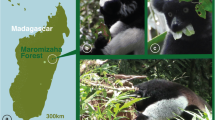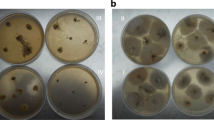Abstract
The greater bulk of soil nitrogen is immobilized in chitinous cell walls of fungi. Mycophagous soil mites participate in chitin decomposition and, hence, in the subsequent mobilization of nitrogen. The source of the chitinolytic enzymes was searched in this study. A multimethodical approach was designed for these studies. Histology, plating and identification of bacteria from mite homogenate and, finally, homogenate and bacterial treatment of the soil fungi were applied. Here the presence and activity of chitinolytic bacteria inside mycophagous mites are reported. These bacteria form an extraintestinal group within the mite’s body and pass their enzymes into the mite’s gut. Our results demonstrate that true mycophagous mites, defined by their ability to digest chitin (i.e. the fungal cell wall), achieve this through internal “cooperation” with chitinolytic bacteria that provide the necessary chitinolytic enzymes. The nitrogen from chitin is thus made available to other soil organisms and plants.



Similar content being viewed by others
References
Aktuganov GE, Melent'ev AI, Kuz'mina LJu, Galimzyanova NF, Shirokov AV (2004) The Chitinolytic Activity of Bacillus Cohn Bacteria Antagonistic to Phytopathogenic Fungi. Microbiology 72:313–317
Citterio B, Malatesta M, Battistelli S, Marcheggiani F, Baffone W, Saltarelli R, Stocchi V, Gazzanelli G (2001) Possible involvement of Pseudomonas fluorescens and Bacillaceae in structural modifications of Tuber borchii fruit bodies. Can J Microbiol 47:264–268
Coleman D, McGinnis JT (1970) Quantification of fungus—small arthropod food chains in the soil. Oikos 21:134–137
Czajkowska B (1970) Rozwój rozkruszków na niektórych gatunkach grzybów. Zesz Problemowe Postepów Nauk Rolniczych 109:219–227
Dinsdale D (1974) The digestive activity of a phthiracarid mite mesenteron. J Zool Soc Lond 174:15–21
Hudson HJ (1986) Fungal biology. Edward Arnold, London, 298 pp
Jaspers E, Overmann J (2004) Ecological significance of microdiversity:identical 16 S rRNA gene sequence can be found in bacteria with highly divergent genomes and ecophysiologies. Appl Environ Microbiol 70:4831–4839
Kjøller A, Struwe S (1982) Microfungi in ecosystems: fungal occurrence and activity in litter and soil. In: A comparative analysis of soil fauna populations and their role in decomposition processes. Petersen, H. and Luxton, M., eds. Oikos 39 (Suppl.) pp 391–422
Kishore GK, Pande S, Podile AR (2005) Chitin-supplemented Foliar Application of Serratia marcescens GPS 5 Improves Control of Late Leaf Spot Disease of Groundnut by Activating Defence-related Enzymes. J Phytopathol 153:169–173
Kobayashi DY, Reedy RM, Bick JA, Oudemans PV (2002) Characterization of chitinase gene from Stenotrophomonas maltophilia Strain 34 S1 and its involvement in biological control. Appl Environ Microbiol 68:1047–1054
Lim HS, Kim YS, Kim SD (1991) YPL-1 Genetic Transformation and Antifungal Mechanism against Fusarium solani, an Agent of Plant Root Rot. Appl Environ Microbiol 57:510–516
Luxton M (1972) Studies on the oribatid mites of a Danish beech wood soil. I. Nutritional biology. Pedobiologia 2:434–463
Mitchell MJ, Parkinson D (1976) Fugal feeding of oribatid mites (Acari: Cryptostigmata) in an aspen woodland soil. Ecology 57:302–312
Molloy C, Burke B (1997) Expression and secretion of Janthinobacterium lividum chitinase in Saccharomyces cerevisiae. Biotechnol Lett 19:1161–1164
O'Neil SE, Heinrich TK, Hales BJ, Hazell LA, Holt DC, Fischer K, Thomas WR (2006) The chitinase allergens Der p15 and Der p18 from Dermatophagoides pteronyssinus. Clin Exp Allergy 36:831–839
Overgaard Nielsen C (1962) Carbohydrates in soil and litter invertebrates. Oikos 13:200–215
Pande YD, Berthet P (1973) Studies on the food and feeding habits of soil Oribatei in a black pine plantation. Oecologia Berl 12:413–426
Pauly F (1956) Zur Biologie einiger Belbiden (Oribatei, Moosmilben) und zur Funktion ihrer pseudostigmatischen Organe. Zoologische Jahrbücher Systematik 84:275–328
Schneider K, Migge S, Norton RA, Scheu S, Langel R, Reineking A, Maraun M (2004) Trophic niche differentiation in soil microarthropods (Oribatida, Acari: evidence from stable isotope ratios (15 N/14 N). Soil Biol Biochem 36:1769–1774
Seniczak S, Stefaniak O (1978) The microflora of the alimentary canal of Oppia nitens (Acarina, Oribatei). Pedobiologia 18:110–119
Siepel H, de Ruiter-Dijkman EM (1993) Feeding guilds of oribatid mites based on their carbohydrase activities. Soil Biol Biochem 25:1491–1497
Shimano S, Matsuo T (2002) Morphological studies on the digestive tract of Scheloribates azumaensis (Acari: Oribatida). J Acarological Soc Jpn 11:37–40
Smrž J (1989) Internal anatomy of Hypochthonius rufulus (Acari, Oribatida). J Morphol 200:215–230
Smrž J (1992) Some adaptive features in the microanatomy of moss-dwelling oribatid mites (Acari: Oribatida) with respect to their ontogenical development. Pedobiologia 36:306–320
Smrž J (1996) Some aspects of the life strategy of oribatid mites. In Acarology IX., Mitchell, Horn, R. D. J., Needham, G. R. and Welbourn, W. C., eds. Ohio Biol. Survey, Columbus, Ohio, USA. pp 553–555
Smrž J (2000) A modified test for chitinase and cellulase activity in soil mites. Pedobiologia 44:186–189
Smrž J (2002a) Nutritional biology: the basic step in the autecological studies (multi-methodical approach). Eur J Soil Biol 38:35–38
Smrž J (2002b) The excrement analysis—the useful tool for the biological and autecological studies in soil zoology. In: Studies on Soil Fauna in Central Europe. Tajovský, K., Balík, V. and Pižl, V. eds. Biology Centre of the Academy of Sciences of the Czech Republic, České Budějovice. pp.185–189
Smrž J (2003) Microanatomical and biological aspects of bacterial associations in Tyrophagus putrescentiae (Acari: Acaridida). Exp Appl Acarol 31:105–113
Smrž J (2006) Microhabitat selection in the simple oribatid community dwelling in epilithic moss cover (Acari: Oribatida). Naturwisseschaften 93:570–576
Smrž J (2007) Nutritional biology in the oribatid mites (Acari: Oribatida) communities in the different, closely neighbouring microhabitats in the steppe biotope—preliminary report. In: Tajovský K, Schlaghamerský J, Pižl V (eds) Contributions to Soil Zoology in Central Europe II. Biology Centre of the Academy of Sciences of the Czech Republic, České Budějovice, pp 153–160
Smrž J, Čatská V (1987) Food selection of the field population of Tyrophagus putrescentiae (Schrank) (Acari, Acaridida). Z Angewadte Entomologie 104:329–335
Smrž J, Čatská V (1989) The effect of the consumption of some soil fungi on the internal microanatomy of the mite Tyrophagus putrescentiae (Schrank)(Acari, Acaridida). Acta Univ Carol Biol 33:81–93
Smrž J, Jungová E (1989) The ecology of a field population of Tyrophagus putrescentiae (Acari, Acaridida). Pedobiologia 33:183–192
Smrž J, Norton RA (2004) Food selection and internal processing in Archegozetes longisetosus (Acari: Oribatida). Pedobiologia 48:111–120
Smrž J, Trelová M (1995) The associations of bacteria and some soil mites (Acari: Oribatida and Acaridida). Acta Zool Fennica 196:120–123
Smrž J, Soukalová H (2008) Mycophagous mites (Acari: Oribatida and Acaridida) and their cooperation with chitinolytic bacteria. In: Bertrand M. Kreiter, S. McCoy, K.D. Migeon A.,Navajas M., Tixier M.-S. Vial L. eds.: Integrative acarology. EURAAC. pp 359–362
Smrž J, Svobodová J, Čatská V (1991) Synergetic participation of Tyrophagus putrescentiae (Schrank) (Acari, Acaridida) and its associated bacteria on the destruction of some soil micromycetes. J Appl Entomol 111:206–210
Stefaniak O, Seniczak S (1976) The microflora of the alimentary canal of Achipteria coleoptrata (Acarina, Oribatei). Pedobiologia 16:185–194
Stefaniak O, Seniczak S (1981) The effect of fungal diet on the development of Oppia nitens (Acari, Oribatei) and on the miocroflora of its alimentary tract. Pedobiologia 21:202–210
Wallwork JA (1976) The distribution and diversity of soil fauna. Academic, London, 353 pp
Wang SL, Chiou SH, Chang WT (1997) Production of chitinase from shellfish waste by Pseudomonas aeruginosa K-187. Proc Natl Sci Counc Repub China 21:71–78
Watanabe T, Oyanagi W, Suzuki K, Tanaka H (1990) Chitinase system of Bacillus circulans WL-12 and importance of chitinase A1 in chitin degradation. J Bacteriol 172:4017–4022
Wigglesworth VB (1974) The Principles of Insect Physiology, 7th edn. Chapman and Hall, London, 827 pp
Wolf MM, Rockett CL (1984) Habitat changes affecting bacterial composition in the alimentary canal of oribatid mites (Acari: Oribatida). Int J Acarol 10:209–215
Zhang Z, Yuen GY, Sarath G, Penheiter AR (2001) Chitinases from the plant disease biocontrol agent, Stenotrophomonas maltophilia C3. Phytopathology 91:204–211
Acknowledgements
The fieldwork and histological work for this study were supported by Grant No. 526/07/0393 from the Grant Agency of the Czech Republic. The other laboratory work was supported by grant MSM 0021620828 from the Ministry of Education of the Czech Republic. We wish to thank ing.M.Doubek, State Health Institute, Prague, for his very kind help with the TEM observations, prof.dr.J.Vávra, Department of Parasitology, Charles University, Prague, who rendered possible to make the ultramicrotome sections and mgr.T.Erban for his information about Dermatophagoides chitinases. We wish to thank also Mrs. Milada Řeháková for her technical help.
Author information
Authors and Affiliations
Corresponding author
Rights and permissions
About this article
Cite this article
Smrž, J., Čatská, V. Mycophagous mites and their internal associated bacteria cooperate to digest chitin in soil. Symbiosis 52, 33–40 (2010). https://doi.org/10.1007/s13199-010-0099-6
Received:
Accepted:
Published:
Issue Date:
DOI: https://doi.org/10.1007/s13199-010-0099-6




